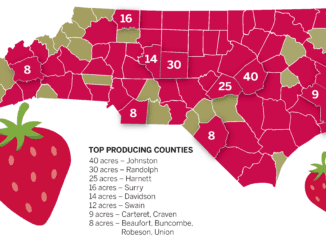
RALEIGH — As North Carolina navigates the aftermath of a global pandemic along with recent spikes in fertilizer, gas and chemical prices, farmers across the state continue to embody the resilience that has nurtured our deep agricultural roots for centuries. Our farming industries currently bring in $95.9 billion annually with projections by the N.C. Department of Agriculture likely to reach $100 billion in the next few years, making agribusiness the top business in the state. Commissioner Steve Troxler credits the grit and innovative spirits of North Carolina’s hardworking farmers and the private and public investment in agricultural research and infrastructure that should position N.C. well in the years ahead.
In a recent interview with NSJ, Troxler framed some of the challenges and innovations on the horizon for our state in its role as a national leader in agriculture production.
NSJ: What are a few examples of investment and innovation from the public and private sector that are currently in place or being planned?
Troxler: A few examples of public and private investment are the BASF Center for Sustainable Agriculture, N.C. State University’s Plant Sciences Initiative and our department’s Steve Troxler Agricultural Sciences Center. These state-of-the-art additions to the ag sciences landscape position this state to be a leader in agricultural science and innovative and transformative ag research. It also means we should be significant contributors in meeting the growing demand for food worldwide. The United Nations predicts farmers today will need to produce 75 to 100 percent more food by 2050 to keep up with demand, so overall we are optimistic about the future of agriculture but understand that farmers are facing considerable challenges today.
NSJ: What are North Carolina’s biggest agricultural products at this time?
Troxler: Livestock accounts for nearly 67 percent of total agricultural cash receipts, so broilers (chickens) -1, hogs-2 and turkeys-3 are among the top commodities. Tobacco-4, soybeans-5, chicken eggs-6, corn-7 and sweet potatoes-8. While sweet potatoes are our eighth largest commodity in North Carolina, our production is significant nationally as our farmers grow more sweet potatoes than any other state. Our production accounts for over half of the total U.S. production. That’s true for other commodities, too. We rank No. 1 in the nation in tobacco, sweet potatoes and cash receipts from chicken and eggs. We are number 2 in hogs and turkeys.
NSJ: How has the pandemic impacted farmers, producers, ag retailers and consumers?
Troxler: We are proud that the agriculture industry really stepped up during the pandemic and continued to work to produce food and fiber. Farmers and producers understood that to ensure a stable food supply, you cannot hit pause on production. We saw some disruptions for dairy producers that resulted in unusable milk and losses, but we also saw increased interest in local food including strong demand for local meats. The demand for local processing quickly exceeded available slaughter capacity as producers sought to bring more products to market.
NSJ: Are there any predictions as to when the High Path Avian Influenza (HPAI) could dissipate and are there any additional measures that your office is considering implementing?
Troxler: That is a difficult question to answer because migratory birds are still passing through the state and we know this virus is in that population, which presents a risk to poultry. The industry remains on heightened alert and we continue to encourage implementing strict biosecurity measures on farms. Testing on farms is continuing statewide and we have prohibited poultry shows and sales to help prevent the spread of this virus.
NSJ: Will the consumer see a major rise in local produce or meat prices at the grocery stores this summer due to inflation, the avian flu, or the war overseas?
Troxler: The U.S. Department of Agriculture’s recently released food price outlook for 2022 projects higher food costs due in part to the conflict between Russia and Ukraine and recent interest rate increases. In that report, food-at-home prices are projected to increase 3 to 4 % in 2022, and 4.5 to 5.5 % in food away from home.
NSJ: How is the current inflation spike impacting our agricultural communities?
Troxler: The cost of doing business has gone up significantly for farmers across the board and we know they are really having to take a pencil to paper to determine what makes sense to grow. Fertilizer costs are up, fuel prices are up, the chemicals used to control weeds and pests have increased. There’s little room for error for farmers this year.
NSJ: What recent programs have been effective and which ones are you hoping to continue to implement that support our farmers and producers?
Troxler: The IMPEC grant program, which stands for Improving Meat Production and Efficiency, has been effective in efforts to increase processing capacity in the state. There has been an increased demand for local meats and that demand from producers for local processing exceeding availability. We have noted wait times for processing slots being backed up a year or more and recognized a need to try to help small processors increase their slaughter and processing capacity. With the support of the legislature, we put federal COVID funds designated for the state to work starting a grant program for meat and seafood processors that has been successful in reducing wait times for processing and increasing our state’s protein capacity. This in turn has This in turn has helped producers. We are proud of this program and what it has been able to accomplish for farmers, processors and consumers.
NSJ: Can you provide any specific figures on fertilizer/gas price increases, labor shortage (if any), supply chain effects, etc?
Troxler: In early March, USDA reported that three types of fertilizer had gone up significantly. Urea has increased 149 percent, liquid nitrogen was up 192 percent and anhydrous ammonia saw a 235 percent increase. We are seeing some inputs running 65 to 100 percent higher as well. In terms of supply change issues, like a number of non-ag industries, we don’t have any figures, but we are seeing delays in parts and equipment with computer chips. Also, some crop chemicals have been in short supply or hard to find.
If you have any additional questions or need additional information on any of the programs mentioned above here a few links to check out:
High Pathogenic Avian Influenza: http://www.ncagr.gov/avianflu/
Included on this link are links to specific relevant topics: What is avian influenza, consumer and food safety, biosecurity, FAQ, backyard flocks, wild birds and hunting, bird shows/sales, commercial poultry.
IMPEC Program: https://www.ncagr.gov/MeatProcessingGrants.htm




